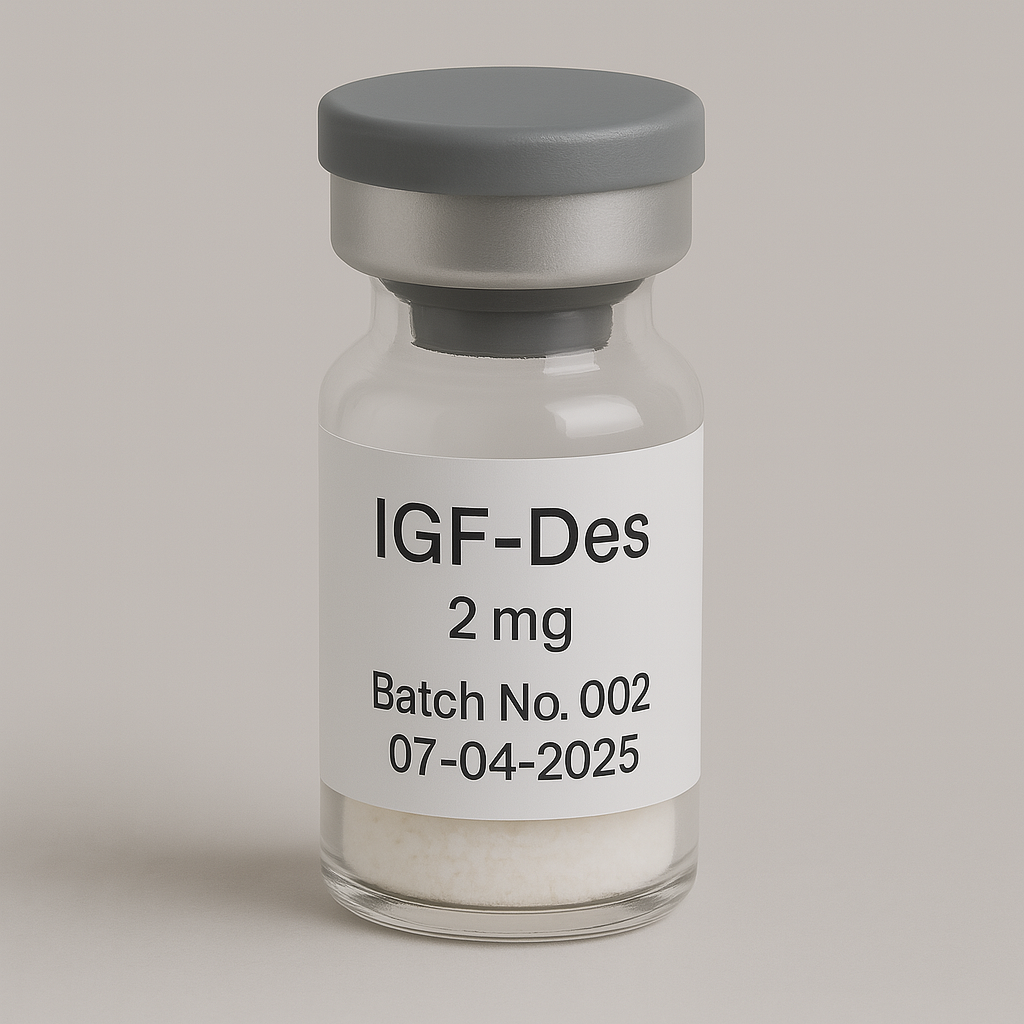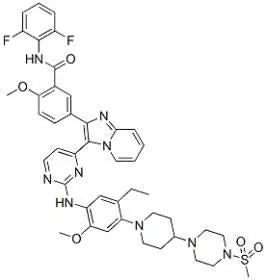
IGF1-Des 2mg vial
Pickup currently not available
NOT FOR HUMAN CONSUMPTION
IGF-1 DES, also known as IGF-1 DES(1-3), is a truncated variant of the naturally occurring peptide hormone Insulin-like Growth Factor 1 (IGF-1). IGF-1 is a critical growth factor that mediates the effects of growth hormone (GH) in tissues, especially muscle, bone, and cartilage. The DES(1-3) form is characterized by the removal of the first three amino acids at the N-terminal, making IGF-1 DES shorter, more potent, and faster-acting than full-length IGF-1.
Chemical and Biological Properties
-
Full Name: IGF-1 DES(1-3)
-
Structure: Shortened variant of IGF-1 with the removal of amino acids 1–3 from the N-terminal end.
-
Molecular Modification: Shorter structure increases potency, affinity for IGF-1 receptors, and resistance to IGF-binding proteins.
-
Administration Routes: Primarily administered via subcutaneous or intramuscular injection due to peptide bioavailability considerations.
Mechanism of Action
IGF-1 DES exhibits enhanced biological activity and rapid action due to key structural differences compared to full-length IGF-1:
1. Increased Receptor Affinity and Potency
-
Greater affinity and potency at IGF-1 receptors, significantly amplifying its anabolic, anti-catabolic, and regenerative effects.
2. Resistance to IGF-Binding Proteins (IGFBPs)
-
Reduced binding affinity to IGFBPs, allowing free circulation and immediate bioactivity, leading to rapid cellular uptake and action.
3. Anabolic and Myogenic Effects
-
Promotes muscle cell proliferation (hyperplasia), differentiation, and growth.
-
Enhances satellite cell activation, critical for muscle repair and hypertrophy.
4. Anti-Catabolic Properties
-
Protects muscle tissue from breakdown, especially in conditions of stress, injury, or caloric deficit.
Potential Therapeutic and Experimental Applications
IGF-1 DES has demonstrated promising results in preclinical research and experimental usage:
1. Muscle Hypertrophy and Athletic Performance
-
Rapid and pronounced muscle growth, improved recovery, and enhanced muscular strength, popular among bodybuilders and athletes experimentally.
2. Muscle-Wasting Conditions
-
Potential therapeutic use in treating muscle atrophy related to chronic illness, aging (sarcopenia), or injury.
3. Injury Rehabilitation and Tissue Repair
-
Accelerates healing of muscle, tendon, ligament injuries, and facilitates rapid rehabilitation following trauma or surgery.
4. Bone Density and Joint Health
-
Improves bone mineral density and may assist in joint healing, potentially beneficial in osteoporosis or joint injuries.
5. Metabolic Health (Experimental)
-
May positively impact insulin sensitivity, lipid metabolism, and overall metabolic function, though less explored than traditional IGF-1.
Dosage and Administration (Experimental Context)
No standardized clinical dosage guidelines currently exist due to the experimental nature of IGF-1 DES. Typical experimental protocols based on anecdotal reports and limited research include:
-
Dosage Range: 20–50 mcg per administration (common experimental dosage: ~25–50 mcg).
-
Route: Usually intramuscular or subcutaneous injection, immediately before or after exercise to maximize localized effects.
-
Frequency: Typically dosed 1–2 times per day during training days or recovery periods.
-
Cycle Length: Commonly 4–6 weeks of use, followed by a break.
Note: Above dosages and practices are anecdotal and experimental; rigorous clinical validation is lacking.
Safety Profile and Side Effects
While IGF-1 DES appears generally well-tolerated in limited experimental contexts, full safety profiles remain unclear due to minimal human studies:
Common Side Effects (Mild and Rarely Severe):
-
Injection site redness, irritation, or minor swelling.
-
Mild headaches or temporary hypoglycemia (due to insulin-like properties; rare).
-
Possible water retention or transient joint discomfort at higher dosages.
Potential Long-term Risks:
-
Theoretical concerns include IGF-1-mediated proliferation of existing tumor cells or altered glucose metabolism.
-
Long-term human studies and chronic safety data remain limited or absent.
Contraindications and Precautions
-
Contraindications:
-
Active cancer or pre-existing tumors (due to theoretical risks of promoting tumor growth).
-
Pregnancy or breastfeeding (unknown safety profile).
-
-
Drug Interactions:
-
Potential interactions with insulin or oral hypoglycemic medications (due to insulin-like metabolic effects).
-
-
Precautions:
-
Individuals with diabetes or impaired glucose tolerance should consult healthcare professionals before experimental use.
-
Legal and Regulatory Status
-
IGF-1 DES is not approved by major regulatory agencies (FDA, EMA, Health Canada) for therapeutic human use.
-
Typically marketed as a research peptide labeled "not for human consumption."
-
Explicitly banned by WADA (World Anti-Doping Agency) for competitive athletes due to significant performance-enhancing properties.
Current Research Status and Evidence
-
Preclinical Research:
-
Extensive animal studies confirm enhanced potency, muscle-building, tissue regeneration, and recovery effects compared to standard IGF-1.
-
-
Human Clinical Trials:
-
Extremely limited; primarily anecdotal evidence from unregulated experimental use.
-
Human research focusing explicitly on IGF-1 DES remains sparse, and standardized clinical studies are necessary for robust validation.
-
-
Limitations and Research Needs:
-
Lack of controlled human clinical studies.
-
Need for established optimal dosing, administration protocols, and long-term safety assessments.
-
Summary of Potential Benefits and Risks
| Potential Benefits | Potential Risks and Limitations |
|---|---|
| Enhanced muscle growth and regeneration | Limited human clinical safety and efficacy data |
| Accelerated injury recovery | Possible tumor-promoting effects (theoretical risk) |
| Improved bone density and joint health | Potential metabolic impacts (e.g., glucose regulation) |
| Anti-catabolic and anabolic properties | Regulatory uncertainty and restrictions |
Future Directions and Research Needs
-
Rigorous human clinical trials to confirm therapeutic efficacy, optimal dosing, and safety.
-
Long-term safety studies to address potential risks related to tumor growth, metabolism, and chronic usage.
-
Exploration of IGF-1 DES’s therapeutic potential in muscle-wasting conditions, injury recovery, and osteoporosis management.
Conclusion
IGF-1 DES is a highly potent, truncated variant of IGF-1 characterized by enhanced bioactivity, resistance to binding proteins, and rapid anabolic and regenerative effects. Although experimental and anecdotal data strongly support its therapeutic promise, significant research gaps, regulatory limitations, and safety concerns remain. Rigorous clinical validation and regulatory approval will be essential before IGF-1 DES can be legitimately recommended for clinical or widespread therapeutic use.
References
-
Philippou, A., & Barton, E. R. (2014). "Optimizing IGF-I for skeletal muscle therapeutics." Growth Hormone & IGF Research, 24(5), 157–163.
-
Shavlakadze, T., & Grounds, M. D. (2006). "Therapeutic interventions for age-related muscle wasting: importance of innervation and exercise for preventing sarcopenia." Journal of Experimental Gerontology, 41(11), 965–981.
Disclaimer:
This review is provided for educational purposes. IGF-1 DES is an experimental research peptide not approved by regulatory authorities for clinical therapeutic use. Always consult healthcare professionals before considering experimental compounds or peptides


